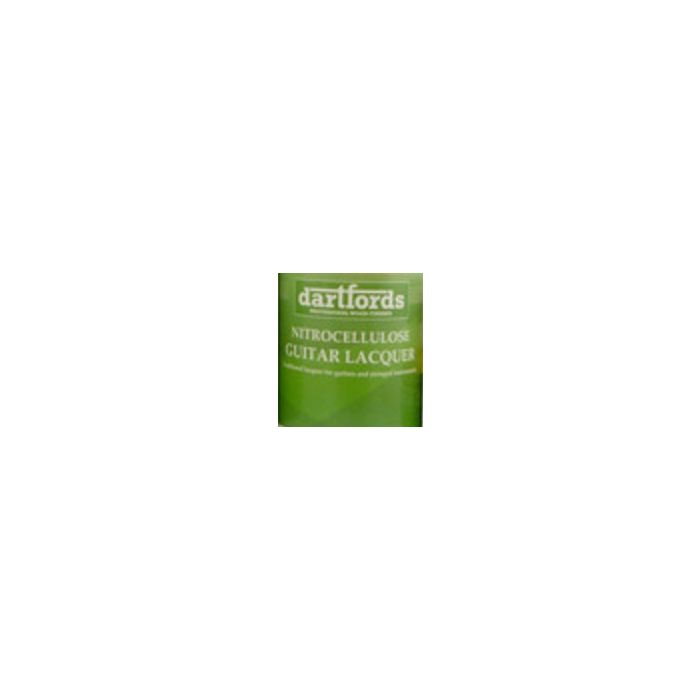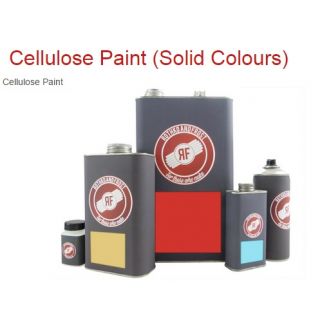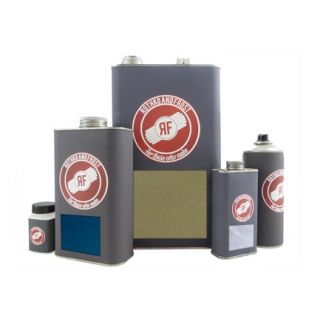Clear nitrocellulose (nitro) top coat lacquer for use on guitars and restoration pieces. Highest quality nitro, made in the UK to dartford’s own spec. This is a true vintage finish making it ideal for vintage guitar builds, repair work and high-end handcrafted instruments.
Available in gloss and satin in handy 230ml can, for use in sprayguns and HVLP kits.
Also available in easy to use aerosols - gloss, satin and matt.
Clear Sanding Sealer/Primer available in both aerosols and 230ml cans.
If using neat nitrocellulose lacquer in a spray gun or HVLP kit it should be thinned (recommend to no more than 30%. ie a ratio of 70:30 (lacquer : thinners). This is merely a guideline, though, not a firm rule - judgement is required as particular thinning ratios depend on a number of factors including equipment, temperature, weather, experience and desired results.
Nitrocellulose lacquer cannot be shipped by air – it is currently delivered by road transport. Always spray in a well ventilated area, keep away from children, pregnant women and animals, and always wear suitable safety equipment including gloves and filtered facemask. Recommended for professional use only.
NITROCELLULOSE LACQUER FAQS
Q. Are there general Spraying Guidelines?
- Thin neat lacquer up to 30% before spraying.
- Spray from a distance of 12 inches.
- The first coat should be a few fine mist sprays, 15 minutes apart. This helps the lacquer adhere to the finish underneath.
- After this, leave 4 hours between coats. After the 4 hours have elapsed key in the finish lightly with 600 grit before spraying the next coat.
- Leave to dry for 2 weeks before polishing.
- Remember that polishing will take some of the lacquer off, so ensure that sufficient thickness is built up prior to polishing to prevent rubbing through to the undercoat.
Please note these are guidelines only as specific spraying conditions will vary.
Q. Which finishes can Nitrocellulose Lacquer be used over?
1K Lacquer No Nitrocellulose lacquer will not adhere to 1K
Acrylic Sanding Sealer No Typically causes bubbling and damage to the acrylic base coat
Bare Wood No For a natural finish first use Clear Cellulose Sanding Sealer, then finish with Clear Nitro Lacquer as a top coat.
Cellulose Paint Yes For either vintage finishes or to achieve a Satin or Matt shine. Otherwise, Cellulose Paint is a top coat and can be polished directly.
Cellulose Sanding Sealer Yes
Metallic Cellulose Paint Yes Metallic paint must have a clear top coat, unlike solid colour cellulose paints which can be polished directly.
Oil No It simply won't stick. If refinishing an oiled body, put a lot of work into removing the old oil finish if possible; otherwise a lacquered finish will never work.
Polyurethane/2K Paint/Lacquer Not recommended as the nitro typically won't stick, and so will peel off easily. Try at your own risk.
Pre-Cat Sanding Sealer No Similar effects to acrylic - bubbling and damage.
Waterborne Sanding Sealer Yes Only dartfords, can't vouch for any other brand as formulations and characteristics vary massively.
Q. Does Clear Nitrocellulose Lacquer look clear in the bottle?
In its neat bottled form it has a light amber colour to it. However, when it dries it dries to a clear finish. Only over time does the dried finish then naturally age and discolour to a slight yellow tinge.
Q. Does this lacquer need to be thinned before use?
Our aerosol spray cans are sealed and ready to spray - simply shake for two minutes before use.
Our bottled lacquer, available in 250ml containers, is intended for use in spray guns and HVLP kits. It needs to be thinned before use. We recommend a thinning ratio of between 80:20 and 70:30 (lacquer : thinners). So, for example, to mix 100ml of ready-to-spray finish you would need approximately 70ml of lacquer and 30ml of thinners.
Q. How much lacquer do I need for a guitar body?
We recommend two aerosols, or 200ml of neat lacquer for an average Stratocaster-sized guitar body. This can vary depending on how you spray, the precise size and shape of your body, and what is underneath.
Q. How big are your aerosol spray cans?
Our aerosol spray cans have a capacity of 400ml. This is made up of:
- 150ml neat lacquer
- 50ml premium anti-bloom thinners
- 200ml propellant
This compares favourably to aerosols from most other suppliers and manufacturers, who use a 1:1 ratio for the lacquer and thinners. I.e., you get less useful lacquer per can. Being a thicker mixture closer to that you would use in a spray gun ours also gives a finer more consistent spray that is less prone to drips.
Q. Can this lacquer be tinted?
Yes, Clear Nitro can be tinted with a variety of products such as:
- Spirit Wood Dyes (up to 10%)
- Aniline Dyes (should be dissolved in alcohol thinners first, then mixed with the nitrocellulose lacquer up to a maximum of 10%)
- Universal Liquid Tinter Dyes
Q. Will this lacquer crack?
Eventually, yes, it always cracks. The real question is how long it takes, and this is really difficult to say. If sprayed properly onto a well prepared base coat and kept at steady room temperature then it will be many years before the finish shows any signs of ageing. a number of factors can reduce this time, some significantly. These include:
- Using an incompatible base coat.
- Spraying onto a contaminated surface.
- Spraying lacquer which has been over-thinned.
- Spraying too many coats too quickly.
- Exposing the finish to large variations in temperature.
- Spraying in very hot conditions.
The most common scenarios where cracking occur are:
- Leaving the finish to dry overnight in somewhere like a garage which goes from warm to very cold.
- Spraying many coats of very thin lacquer.
- Spraying over an old finish which has been contaminated with silicones.
- Using plumber's Pipe Freeze or similar on the finish to cool it very quickly.
- Placing the body near a very hot radiator.
Cracking of the lacquer through poor adhesion or over thinning tends to be a crazing effect all over. Cracking due to wood expansion/contraction tends to be larger cracks focussed around drill holes.
Q. Does Nitro Lacquer discolour?
Yes, eventually. It gradually turns from clear to yellow. The effect of this is that any colour(s) underneath will take on a yellow tinge, so blue paint will look more green, red finishes will look more orange etc.
This discolouration is commonly seen on vintage guitars. This effect is the result of two effects:
- Discolouration of the lacquer itself through age.
- Build-up of dirt, grime and other external contaminants such as tobacco smoke.
If an instant discoloured/aged look is desired then once this clear coat has been sprayed one of our Tinted Nitrocellulose Lacquers can be sprayed over the top. We recommend our Light Brown or Weakest Amber lacquers for this purpose.
Q. How do I polish this finish?
As a guideline, use the following process for hand polishing nitro finishes:
- Allow the lacquer to dry for two weeks.
- Wet sand the finish, starting with 600 grit. Work in straight lines, first across the workpiece and then lengthways.
- Repeat with 800 > 1000 > 1200 > 1500 and finally 2000 grit.
- Use RF3 Liquid Polishing Compound and a clean soft microfibre cloth. As with the wet/dry paper, work in straight lines, first across the workpiece and then lengthways.
- Repeat with RF5 and RF7 Liquid Polishing Compounds. Use a different cloth for each grade to prevent contamination.
| Shipping | Dangerous Goods |
|---|





